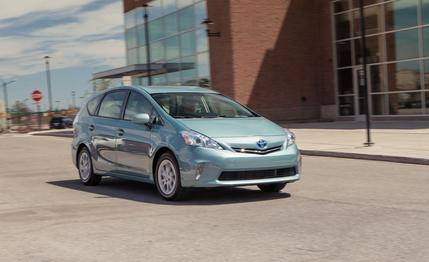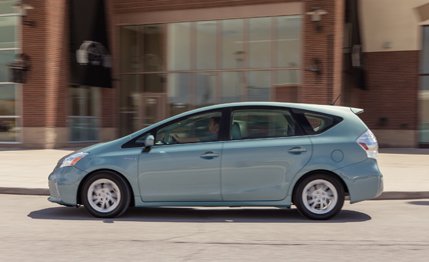 Instrumented Test
TESTED
Instrumented Test
TESTED
For many buyers, the Toyota Prius is to hybrid vehicles what Xerox is to photocopiers: a synonym and an archetype. All hybrids are Priuses, to many who don’t read car magazines, and that’s what Toyota gets for being first with a good product. A couple of years ago, Toyota’s popular hybrid had kittens and expanded into three sizes, with the diminutive Prius C on the bottom, the regular Prius and Prius plug-in hatchbacks in the middle, and the Prius V wagon on top. Considering that the Prius family rang up more than 236,000 sales in 2012, the idea seems to have been another winner for Toyota.
Papa Bear of Priuses
The Prius V grows to size-XL by getting a three-inches-longer wheelbase and another 6.0 inches in overall length, with a 70-percent increase in maximum cargo space, thanks to a roof that is flattened out and carried back, wagon style, to a nearly vertical hatchback. With the rear seats up, the V offers 34 cubic feet, a considerable volume when most mid-size sedans have trunks in the 15-to-19-cubic-foot range. Fold the middle seats (nearly) flat, and you have a hangar: 67 cubes.
Those stats would put the Prius V at the large end of the class of compact crossovers that includes the Honda CR-V and Ford Escape. Nobody who is consigned to the second row of the Prius V will complain about a lack of space. For being a car, this car is simply big, inside and out.

Far from Penurious
Toyota has broken down the Prius V model range into three trim levels called, simply, Two, Three, and Five. Don’t ask us why there is no Four, as there is with the hatchback Prius. At first blush, the Prius V Two’s starting price of $27,445 seems a considerable leap (of $2450) over the base price of the smaller Prius Two hatchback. Besides the extra sheetmetal in the wagon, you get a couple of items standard in the V, such as a backup camera and adjustable lumbar support.
As you graduate up to the Three and Five, amenities such as heated front seats pile on. Plus, you can purchase optional extras such as a panoramic sunroof, radar cruise control, auto parking, blind-spot warning alarms, Toyota’s Entune smartphone-integrating infotainment system, and so on. The Entune system takes some getting used to, but it leverages the power of the app universe to ensure that its electronics don’t quickly get stale and outdated. Play fast and loose with the options, and a V can top out close to $39,000. One thing the V doesn’t offer currently is a power liftgate, which, for anyone who has grown accustomed to this simple pleasure, might be a deal breaker.
Once the hatch is open, the opportunities for loading stuff are great. A full-size men’s mountain bike slid in with no trouble once the front wheel was removed. The hybrid batteries in back make for a high load floor, and the middle seats have a nicely textured hard-plastic surface on their backs, which is bound to get scraped up and ravaged over time. Owners who like to keep their cars pristine will want to keep blankets handy to protect the V’s handsome interior.